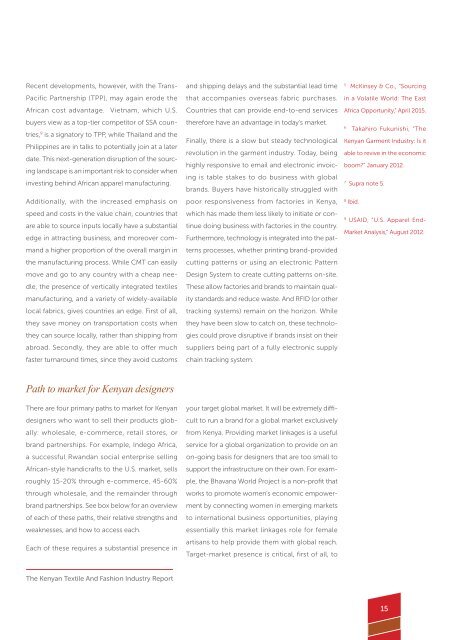Create successful ePaper yourself
Turn your PDF publications into a flip-book with our unique Google optimized e-Paper software.
Recent developments, however, with the Trans-<br />
Pacific Partnership (TPP), may again erode the<br />
African cost advantage. Vietnam, which U.S.<br />
buyers view as a top-tier competitor of SSA countries,<br />
9 is a signatory to TPP, while Thailand and the<br />
Philippines are in talks to potentially join at a later<br />
date. This next-generation disruption of the sourcing<br />
landscape is an important risk to consider when<br />
investing behind African apparel manufacturing.<br />
Additionally, with the increased emphasis on<br />
speed and costs in the value chain, countries that<br />
are able to source inputs locally have a substantial<br />
edge in attracting business, and moreover command<br />
a higher proportion of the overall margin in<br />
the manufacturing process. While CMT can easily<br />
move and go to any country with a cheap needle,<br />
the presence of vertically integrated textiles<br />
manufacturing, and a variety of widely-available<br />
local fabrics, gives countries an edge. First of all,<br />
they save money on transportation costs when<br />
they can source locally, rather than shipping from<br />
abroad. Secondly, they are able to offer much<br />
faster turnaround times, since they avoid customs<br />
and shipping delays and the substantial lead time<br />
that accompanies overseas fabric purchases.<br />
Countries that can provide end-to-end services<br />
therefore have an advantage in today’s market.<br />
Finally, there is a slow but steady technological<br />
revolution in the garment industry. Today, being<br />
highly responsive to email and electronic invoicing<br />
is table stakes to do business with global<br />
brands. Buyers have historically struggled with<br />
poor responsiveness from factories in Kenya,<br />
which has made them less likely to initiate or continue<br />
doing business with factories in the country.<br />
Furthermore, technology is integrated into the patterns<br />
processes, whether printing brand-provided<br />
cutting patterns or using an electronic Pattern<br />
Design System to create cutting patterns on-site.<br />
These allow factories and brands to maintain quality<br />
standards and reduce waste. And RFID (or other<br />
tracking systems) remain on the horizon. While<br />
they have been slow to catch on, these technologies<br />
could prove disruptive if brands insist on their<br />
suppliers being part of a fully electronic supply<br />
chain tracking system.<br />
5<br />
McKinsey & Co., “Sourcing<br />
in a Volatile World: The East<br />
Africa Opportunity,” April 2015.<br />
6<br />
Takahiro Fukunishi, “The<br />
Kenyan Garment Industry: Is it<br />
able to revive in the economic<br />
boom?” January 2012.<br />
7<br />
Supra note 5.<br />
8<br />
Ibid.<br />
9<br />
USAID, “U.S. Apparel End-<br />
Market Analysis,” August 2012.<br />
Path to market for Kenyan designers<br />
There are four primary paths to market for Kenyan<br />
designers who want to sell their products globally:<br />
wholesale, e-commerce, retail stores, or<br />
brand partnerships. For example, Indego Africa,<br />
a successful Rwandan social enterprise selling<br />
African-style handicrafts to the U.S. market, sells<br />
roughly 15-20% through e-commerce, 45-60%<br />
through wholesale, and the remainder through<br />
brand partnerships. See box below for an overview<br />
of each of these paths, their relative strengths and<br />
weaknesses, and how to access each.<br />
Each of these requires a substantial presence in<br />
your target global market. It will be extremely difficult<br />
to run a brand for a global market exclusively<br />
from Kenya. Providing market linkages is a useful<br />
service for a global organization to provide on an<br />
on-going basis for designers that are too small to<br />
support the infrastructure on their own. For example,<br />
the Bhavana World Project is a non-profit that<br />
works to promote women’s economic empowerment<br />
by connecting women in emerging markets<br />
to international business opportunities, playing<br />
essentially this market linkages role for female<br />
artisans to help provide them with global reach.<br />
Target-market presence is critical, first of all, to<br />
The Kenyan Textile And Fashion Industry Report<br />
15


